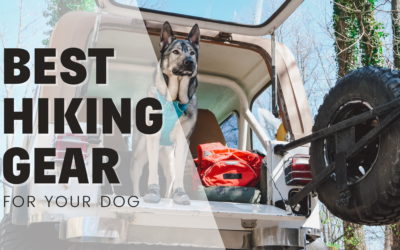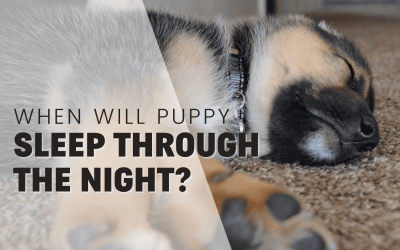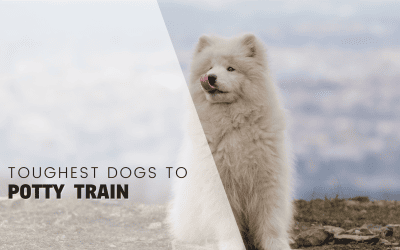A rumour went around the dog world, and you might be asking “will playing tug make my dog aggressive?”
It’s a fair concern, given the competitive nature of the game and the seemingly aggressive tugging involved – especially if you start getting a growl out of your dog, it’s easy to get scared.
In this blog post, we aim to dispel any notions of fear and uncertainty surrounding this topic. We delve into understanding dog behavior, the misconceptions surrounding tug of war, and dog aggression. And together, we’ll uncover the truth as to whether this favored playtime activity could potentially foster aggressive behaviors in your furry friend.
Rest assured, we want to ensure that your dog has a fun, healthy, and safe playtime. So, let’s embark on this enlightening journey to understand our dogs better.
Will tug make my dog aggressive?
Playing tug with your dog doesn’t inherently make them aggressive. In fact, tug can actually promote impulse control, build confidence, and strengthen the bond between dogs and their owners. However, it is essential to note that while tug of war might not make a dog aggressive, it could potentially be the trigger for misbehavior, or encourage your pup to lose their control a little if they’ve not quite mastered the ability to self regulate.
In most cases, playing tug of war does not lead to aggression. It’s a common activity that many professional dog trainers (like myself!) even use as a reinforcement or reward during training and agility exercises. Research has shown that dogs who play tug of war regularly are not aggressive but instead have more confidence in their day to day life!
Where did this myth come from?
The belief that playing tug-of-war games makes dogs aggressive might come from misunderstandings of dog behavior. The believe that “Tug of war bad” is probably to do with the vigorous tugging of the game to be a sign of aggression, or to worsen a dogs desire to bite, leading to an incorrect association between the game and aggressive behavior in dogs.
The initial presumption also could have emerged from the notion that tug of war might incite aggression by overstimulating a dog’s assertiveness or predatory instincts. This notion seems to have taken roots among earlier animal behavior experts, contributing significantly to the spread of this myth.
However, modern dog trainers and animal behavior experts agree that this simply isn’t true. Typically, we find tug to be a healthy, stimulating game that can even serve as a training exercise!
We have to remember that for a long time, science wasn’t readily available to dog trainers, as it was kind of safe guarded, and the lack of the internet meant that everyone kind of came up with their own theories, and ran with it. Luckily, as the dog training world gains more voluntary regulation, and more qualifications, we’re starting to see a rise in the quality of dog training, and a number of these myths being firmly debunked.
So do I need to win our tug games?
The great news is no, you don’t need to win your tug games. This one comes from the dominance theory idea that if you don’t win, you’re not the alpha and it will encourage dominant behaviors. And in fact, there were scientific studies done on this games of tug of war and whether they resulted in “dominance” – the conclusion was no… (See article in the journal of applied animal welfare science – but do note this was right around the period that dominance as a theory was debunked) and … well… we know that’s not true because dog’s not need alphas! Dogs simply need an engaging partner in crime with whom working with is fun and they’ll literally do anything you ask!
In fact, the contrary is true! letting your dog win often, with moderate challenge is the ideal way to play tug with your dog. It’s all about the cycle of reward, right?
Benefits of playing tug with your dog
Tug is actually hugely beneficial to do with your dog, and has a significant number of benefits for you and your dog.
- Bonding: Playing tug of war with your dog provides focused, one-on-one time, allowing you to communicate and interact closely with your pet. Over time, this shared experience can deepen the emotional connection and mutual trust between you and your dog.
- Physical exercise: it’s really great exercise on a rainy or hot day. Tug is a physically demanding game that engages various muscle groups in your dog’s body, including their neck, shoulders, and legs. This workout not only helps maintain their strength but is also a great outlet for energy!
- Mental stimulation: The game of tug of war is mentally engaging for dogs as it requires concentration, problem-solving, and decision-making skills. This mental stimulation can help keep their mind active and sharp, preventing boredom and minimizing the likelihood of destructive behaviors.
- Impulse control: When played with ground rules like “take it” and “drop it” commands, tug of war helps dogs learn self-control and patience. Dogs will learn to wait for your cue before grabbing the toy and releasing it upon command, thus improving impulse control and obedience.
- Confidence-building: Engaging in a game where your dog successfully tugs and wins the toy can boost their self-confidence. This can be particularly helpful for timid dogs or dogs with anxiety issues, as winning the game helps foster a sense of accomplishment and enhances their trust in themselves and their owner.
- Reinforcement during training: Using tug of war as a form of reward or reinforcement during training sessions can make learning more enjoyable and engaging for your dog. This can lead to a more motivated pet who is eager to follow your commands, as they associate the game with positive reinforcement.
- Redirecting energy: Dogs often have excess energy that needs to be channeled appropriately to prevent negative behaviors like chewing on furniture or excessive barking. Tug serves as a healthy outlet for them to expend this energy, ensuring they’re more relaxed and well-behaved around the house.
- Building cooperation: Tug of war encourages your dog to work cooperatively with you to play the game. This cooperative interaction deepens the bond between you and your pet and reinforces their understanding of you as a source of guidance, fun, and support.
- Oral health exercise: Playing tug can help exercise your dog’s jaw muscles, promoting their oral health. The tugging motion, especially with a textured or rope toy, can also help gently clean their teeth and gums, contributing to better dental hygiene.
What does cause aggression?
Aggression in dogs is typically defined as threatening behavior directed towards another individual, which can include snarling, growling, snapping, biting, barking, or lunging. It’s crucial to understand the contributing factors to aggression, as it can help in its prevention and treatment.
Here are some common causes of aggression in dogs:
- Genetic Traits: Most often from my experience, aggression (or reactivity) is genetic. It comes from one of their parents or grandparents, and is a sign (typically) of an irresponsible breeding program.
- Lack of Socialization: Dogs that have not been adequately socialized may struggle to interpret other dogs’ behaviors or human actions, which can lead to aggressive tendencies due to fear or misunderstanding.
- Abuse: A dog who has been abused in the past can escalate towards aggression faster than other dogs, as they have historically learned that their more subtle displays of discomfort are not read or deliberately ignored.
- Fear or Fear Based Training methods: Fearful dogs can exhibit aggression as a defensive gesture when they feel there’s a threat. This is often seen as a response to situations that cause anxiety or stress. This can also arise from outdated training methods being used on our dogs, such as the use of e-collars and prong collars.
- Illness or Injury: Just like humans, dogs that are in pain or sick may become irritable. Such dogs may show aggressive behaviors because they want to protect themselves from more discomfort or harm.
- Territorial Aggression: Some dogs may become aggressive when they are defending their territory. This could be their home, family, or resources like toys or food.
- Resource guarding: Dogs may showcase aggressive behavior when trying to guard their valued possessions like food, toys, or particular spaces, from what they perceive as threats.
Behavioral adjustment and management of aggression in dogs often involve spotting the cause and working with a professional dog trainer or behaviorist to devise a suitable training plan.
Early identification, along with continuous training using positive reinforcement methods, can lead to a significant improvement in the dog’s behavior and reduction in its aggressive tendencies.
Play vs aggression
Tug of war is a natural behavior in dogs because it closely resembles behaviors and actions that dogs would use in the wild, making it instinctively appealing. More specifically, it mirrors the “bite-kill” action as part of the predatory motor pattern. This might sound grisly when you’re looking at your fluffy labradoodle, but it’s just a part of their primal nature! Not to mention why they were selectively bred to assist humanity for centuries!
By instinct, dogs are playful creatures. Play behavior in dogs, and indeed in all animals, is a way to prepare them for adult life, helping to develop social, cognitive, and physical skills. Therefore, the tug of war’s back-and-forth motion simulates these survival skills, giving dogs a ‘safe’ way to keep these instincts sharp in a domesticated setting.
Lastly, like all play, tug triggers the release of endorphins or ‘feel-good’ chemicals in dogs’ brains, resulting in them enjoying the game and wanting to repeat it, hence strengthening the natural behavior.
Tips for safely playing tug with your dog
Here are some tips for safely playing tug of war with your dog, and most of it is simply recognising some simple signs of aggression.
- Choose the right toy: Opt for a toy that’s durable and easy to grip, like a tug rope or a robust rubber bar. Ensure it’s sufficiently long to keep your hands a safe distance from your dog’s mouth during play.
- Side to side, back and forth, but not up and down: it’s a good idea to avoid the up and down motion when tugging because your dog’s neck is just not built to move in this way, the right way will be the “biologically appropriate” ways, of side to side and back and forth.
- Cues can help: Establish cues such as “take it,” “drop it,” or “leave it.” These help maintain control during the game and instruct your dog when to commence or cease tugging.
- Let your dog win: Like any game, it’s important to let your dog win some of the time. This will help boost his self-esteem and make him more willing to play again in the future. With a timid dog, you may want to go super easy on them to start to show them how much fun it can be.
- Monitor your dog’s body language: Always be attentive to your dog’s body language to ascertain if they’re enjoying the game and not getting overly aggressive or stressed.
- Take breaks: Intermittently give your dog a break to regain composure and keep any excitement from escalating.
- Positive reinforcement: Reward your dog with praise, treats, or additional play when they accurately follow your cue, reinforcing beneficial conduct.
- We only engage with a toy in between: one of the fundamental rules of the game is that there is no contact with human skin (because we’re shockingly delicate beings)
- Go easy on pups and senior dogs: it can be tempting to go hell for leather with a good game of tug, but tug sessions need to be tailored to our dog’s abilities.
By taking these points into account, tug of war can be a healthy, safe, and enjoyable activity for both you!
What Should You Watch Out For
Determining whether a dog is playing or displaying aggression could be sometimes challenging, as some of the behaviors can look similar. Here are several warning signs you can look out for:
- Body stance: A dog displaying aggressive behavior typically has a tense, rigid body posture. The dog may lean forward, almost as if poised for attack.
- Ears and tail: In situations of aggression, a dog’s ears are often pinned back, and the tail is usually held high and rigid. However, remember that these signals can be breed-specific, as some breeds possess different ear and tail characteristics.
- Growling and snarling: While growling can be part of play, when it comes in a lower pitch and intensified volume, accompanied by snarling (showing teeth), it often indicates aggression.
- Bared teeth: Unlike a play bite where a dog’s mouth might be open and relaxed, an aggressive dog usually has its lips curled up and teeth bared.
- Lack of play signals: Dogs, when playing, often exhibit certain behaviors like a ‘play bow’ (sticking their rear in the air and leaning forward on their front paws). The absence of these behaviors could suggest your dogs aren’t in a playful mood.
A lot of this comes down to learning your dog and how they communicate, and, honestly, when you hear a serious “I mean it” growl? You know the difference.
Examine your dog’s behavior as a whole. If you see several of these signs together or if your dog’s behavior changes rapidly, it may be time to intervene and calm your dog down, thereby preventing any aggressive actions.
Tug Toys We Love
From rope toys to a squeaky toy, there’s tonnes of toys that can give you a good game of tub, but here’s our shortlist of the best tug toys we’ve found (they have good grip, and they’re durable too!)

- 23" of tough fluff - the big daddy gator is a staple in our home. It's big, it's tough and it's awesome double stitching means that whilst you're paying more now? This gator is worth the investment
- Tug it, Throw It, Squeak It - This is your perfect all round toy for every game, and every mood. your pup brings to you.
- Large toy - it is a little large, so for smaller doggo's you might consider Fluff and Tuff's other crocodillian/alligator-y toys, as their long body really does make them perfect for an engaging game.
- No eyes, no nose, no shred - with stitched eyes, double-layered material and extra durable stitching, this fluff & Tuff gator is really the king of toys, It took my shepherd years of playing with this one before it became just a little bit knackered - but you can see the images of that!

- Hemmed Jute - this material is the same as what comes in the bite suits they wear when doing proper bite work, so you know this thing can stand up to the challenge of any dog.
- Two handles - getting a good grip on this toy is super easy as it does have the two handled - which can dissuade dogs who like to try and chew your knuckles...
- Tough - because of the jute structure and it's quality production, this tug toy from Fenrir really gives you reliability for your money
- Really engaging - because you can really get into this, this works well for new tuggers to pro-tuggers alike!
- No squeaker - exhausted with your dog running around squeaking everything to oblivion? This one doesn't have a squeaker, so your home will be squeak free! (well, except for maybe the floorboards, as this toy won't fix those!)

- For Ball Lovers - The best part of this, is this is one really great way to get a ball-loving dog into tug - or reward a ball lover without throwing a ball (which may not be appropriate when walking alongside a busy road)
- Bungee handle - If you're struggling to deal with the impact of your dog's tug, this will absorb that impact, which makes it really good for you!
Whilst we love these toys, don’t forget, playing with your dog doesn’t have to be expensive or fancy! An old tea-towl, a stick, or even an old pair of jeans can easily repurpose into a tug toy.
Tug Is A Rewarding Experience For Everyone!
In conclusion, tug of war is much more than a simple game—it’s a great way to bond with your furry friend and channel their natural instincts in a positive and controlled manner – making it a really fun game. Not only does this game meet your dog’s psychological need for play and stimulation, but it also provides great physical exercise, which is vital for their overall health and wellbeing.
Remember, not all dog’s love tug, it may take building, or your dog may just not be into it! You can always try, but if your’s is just the type of dog that doesn’t love it? There’s always ways to play.
So, dog parents, let’s pick up that tug toy and engage in an exciting game with our furry friends! Canine playtime is an essential part of their day, and tug of war could be just the perfect game. It’s all about knowing how to play safely and responsibly, and then making the most of the playful moments with your furry buddy.

Author, Ali Smith
Ali Smith is a professional, qualified, and multi-award winning trainer is the founder of rebarkable. She has always believed animals deserve kindness and champions force free methods. Believing that dog guardians will all choose the kindest options if proper information is provided, she aims to help all dog guardians who need it and make dog training as accessible as possible
Ali lives win Maryland, US with her husband and her three dogs.






0 Comments